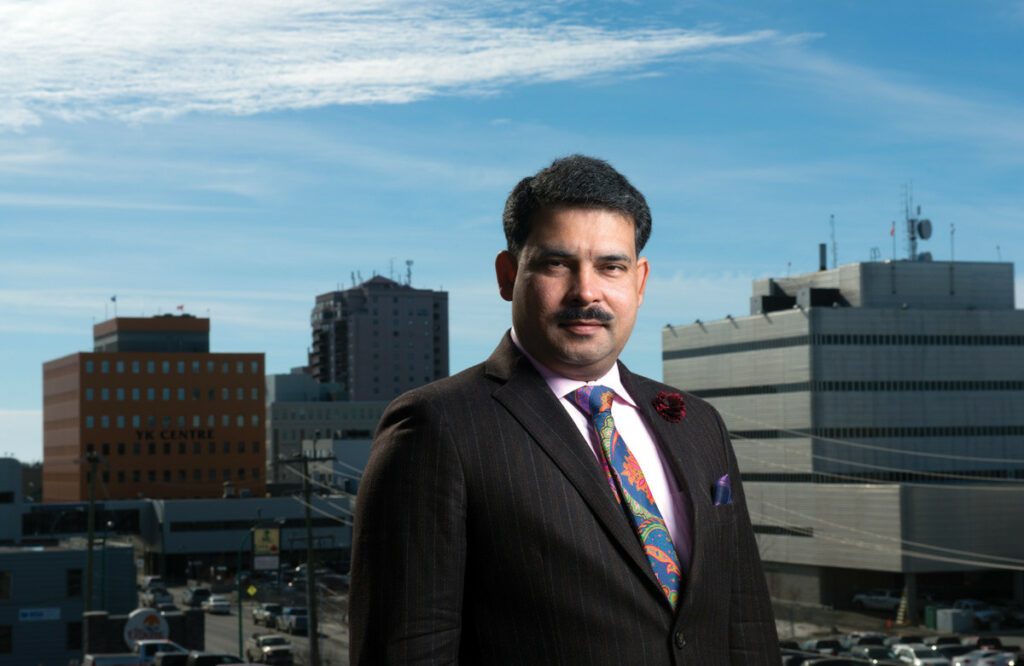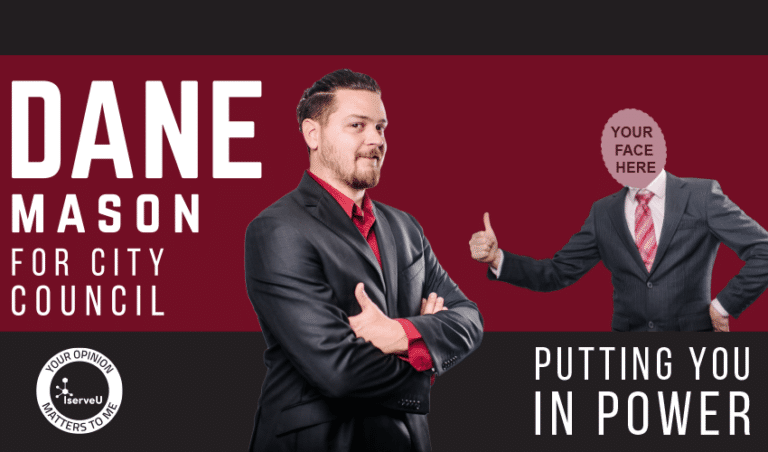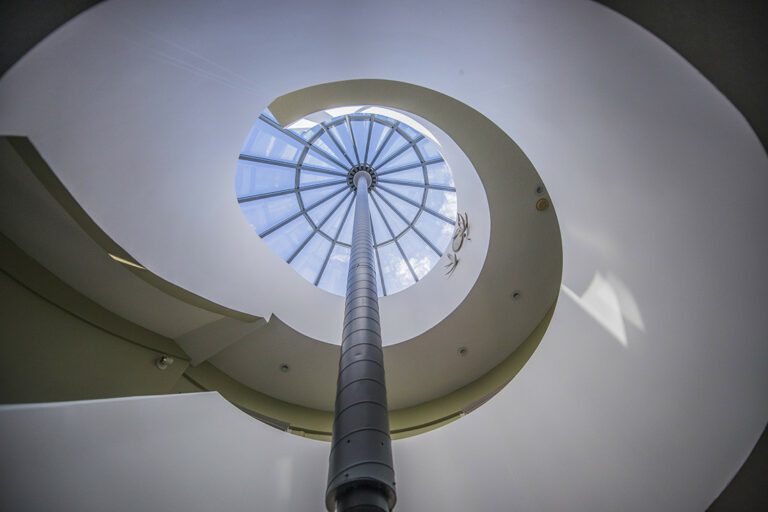Deepak Kumar: Yellowknife’s somewhat mysterious new diamond king
by Jack Danylchuk
Spring came late this year to Yellowknife and Archibald Street, the block-long huddle of single-storey buildings that was known as Diamond Row when the city’s claim to be ‘Diamond Capital of North America’ was more than a hollow boast.
Spring is the season of renewal, the time Deepak Kumar appointed as the new beginning for diamond processing in Yellowknife – an industry that all but vanished from the city in 2009, when the last factory operating on Archibald Street closed its doors and left the territorial government tallying the losses on its $22-million investment. At last count that hole was $6-million deep.
“It will be a bit later,” Kumar confesses at a breakfast meeting in early May at the Explorer Hotel, which has been like a second home since early January when Industry, Tourism and Investment Minister Dave Ramsay revealed that Kumar was the mystery man behind the only offer to purchase the two vacant buildings.
Since then, Kumar has been the subject of wonder and speculation. Even within the Diamond Bourse of Canada – a trading facility and industry association that accepted him as a member just last year – Kumar is something of a mystery. “Who is backing him?” is the question most frequently asked by fellow Bourse members.
Deepak is an ancient Sanskrit word for lamp, but Kumar won’t say anything that will shine light on the total cost of his venture or the source of his financing, except that “not a single penny comes from the territorial government.”
He orders fruit, yoghurt, whole-wheat toast and tea, selections that follow the dictates of a lacto-vegetarian diet of his faith. A Hindu, and a Brahmin, Kumar came to Canada a decade ago, “for love,” he says. He shifts from a seat across the table – escaping the glare of the morning sun – to a closer and more confidential corner placement, and leans forward, projecting himself toward the camera lens, voice recorder, and interviewer.
The captured voice and image are those of a confident, self-assured man of 42, educated, articulate, determined to make his point, sell his idea. He is a few inches over five feet, barrel-chested and dapper in a tailored suit of brown wool with fine orange and grey pin stripes, a shirt of pink and white stripes, a vivid power tie, and a bright flower on his lapel. On his left hand is a heavy gold marriage ring, on his right, a single northern diamond sparkles from a white gold setting, and beside it, a pale sapphire that was a graduation gift from his grandmother.
Ducks in a row
Kumar has just returned from a business trip that took him to India, Israel, Belgium, and New York. He personally oversaw the packing of the shipping containers that were now on their way to Yellowknife with equipment for the factory. “Especially when you are just starting, you want to make sure that all the ducks are in a row,” he explains.
The equipment boasts the latest technological innovations. The polishing benches have a built-in vacuum system to whisk away carbon dust, which Kumar regards as a health hazard – the source of respiratory problems experienced by polishers in later life.
“Technology is changing so fast,” he exclaims. “New technology is entering the market every month. The cost of just one machine, which will be the first of its kind in North America, is $2 million.”
Deepak International Diamonds has agreed to pay the territorial government $1.795 million for the Archibald Street buildings – a $105,000 discount from the list price, but only a fraction of the outlay needed to finance the company’s ambitious plans. Experts put that number in the neighbourhood of $50 million.
“It is close to that,” Kumar says, smiling. “But I will give you a different answer. You need a total investment that is a large part of millions of dollars. Because I can tell you that when you operate in Yellowknife, you want to be sure you are getting the best equipment.”
One of the challenges that eventually defeated the companies that came before Deepak International was cash flow – the need to hold valuable inventory and continue to buy rough stones as they became available from the mines. And operating costs. Everything is more expensive in Yellowknife.
“We have sufficient resources; I would not put myself in this situation if I didn’t have all my ducks in a row,” says Kumar. “The business has changed from how it was done 10 years ago. Successful companies sailed through the recession (of 2008 that felled many luxury goods dealers) because they had the right business model. We don’t foresee any problems.
“Technology has made a huge difference. A worker can polish one stone an hour, not just one stone a day,” he says, “if you have efficiencies and proper procedures in place.”
Article continues below advertisement
Asian factories no longer have the advantage of low wage costs, he adds. “A decade ago in India, a diamond cutter would work for $200 a month. Now the economy is booming; there are inflationary pressures on food, housing, the pay is not less than $5,000 a month.”
Kumar says he is recruiting employees in Yellowknife from a pool of cutters and polishers who remained after the last factory closed in 2009. When the plant opens this summer “you will see familiar faces, people who worked here.”
It’s unlikely that Matveos Hrutyunyan will be among those going to work for Deepak International. An expert diamond cutter and polisher with more than 20 years experience, he stayed in Yellowknife and turned to driving taxi when Arslanian closed. It pays much more than Kumar has been offering, he says.
“I know Kumar; I’ve given him a ride more than once, and he knows that I am an Armenian, but he has never spoken to me about working,” says Hrutyunyan. “But I’ve heard what he has offered others – $20 an hour. We were paid more than that at Arslanian. I make much more than that now. I think he will have to bring workers from India.”
Yet Kumar insists that local workers are key. “If you want to have a long-lasting manufacturing industry in Yellowknife, and if you want Yellowknife to be host to long-range diamond manufacturing, we have to make sure we have local people trained.
“Once you have a foundation in cutting and polishing, it is a simple matter of a month or so of training to transition to the new technology,” he says. “It’s not rocket science; everything is computerized. All you need is a knowledge of English.”
While seemingly forthcoming about his labour plans, Kumar’s personal reserve and reticence lend an air of mystery and romance to his backstory. One interviewer reported shortly after he arrived in Behchoko in 2003 that Kumar followed the woman he married to Canada after meeting her in Mumbai where she was vacationing.
“No, it’s not like that all,” he laughs, “Who told you that? You can say that love brought me to the NWT. When I came here in summer and the warmth of a small community. I looked like everybody else, so I fit right in.
“The RCMP gave me a job as a guard. It was a wonderful experience. It helped me become a better Canadian. I worked as a substitute at the school where my wife was a teacher, and I worked briefly for ITI. With three jobs in a small community, working 16 hours a day, I could save money.”
But did he really want to work 16 hours a day, when just down the road, diamonds were being cut, polished and marketed? In India, Kumar says his family has been “in the diamond and jewelry business for many generations.
“I went to the factories, introduced myself, and they agreed to supply cut and polished stones. But living in Rae-Edzo, what kind of business can you do, even if technology has given us global reach?”
He moved the business and his family to Edmonton in 2006 because it was one less flight connection to make on the way to Toronto, home to most of the members of the Diamond Bourse of Canada.
Wanted to be close to YK
“I didn’t go to Toronto, because I always wanted to be close to Yellowknife. My children were born in Stanton Hospital. I have an attachment to the place. I’m known as the man from the NWT and I take great pride in that. And Edmonton is a much safer place than Toronto.”
Safety and security are serious concerns for Kumar – and insurance companies. He won’t divulge the names of his wife or children. The diamond industry is a “soft target” for criminals, he says, but he is taken aback when it’s pointed out that his home address in one of the newer subdivisions in south Edmonton is available through basic computer and research skills. Anyone who knew that Kumar was a diamond dealer would have no trouble following Google Earth to his front door.
“In the next few weeks you’ll see a new website, with new information,” he says, and the business that has operated from Kumar’s home, computer and cell phones will move to offices in Yellowknife and Toronto.
To start his business as a diamond dealer, Kumar tapped markets in China, aided in large measure, he says, by changes the territorial government brought to how business was done – “providing a chain-of-custody certificate that assured buyers that their gems had come from the North. Before that, you could never know where a diamond came from.
“Slowly, slowly, slowly I built the business with stones polished in Yellowknife. When the factories closed, I imported from India, to maintain a relationship with my clients. When this opportunity came up, I applied.”
In the same announcement that revealed Kumar as the secret buyer of the Archibald Street properties, Ramsay bestowed approved-diamond-manufacturer status on Deepak International, and gave him exclusive rights to the Polar Bear brand that the government won in a court fight with Sirius Diamonds, one of the original Diamond Row companies.
“We will market it through an exclusive dealer network around the globe,” Kumar says. “It will have the same cachet as Rolex and Cartier. You make the customer feel special when they purchase the Polar Bear diamond; they get a sense of exclusivity and pride in their purchase.”
Sirius and its successor, Arslanian Cutting Works, discovered that the market was reluctant to pay a 10 to 15 per cent premium for diamonds processed in the North, regardless of their pedigree. Kumar won’t speak to that, but says, “I was here when those factories were operating. I couldn’t tell them how to run their business, but I have ideas.
Unique place, unique business
“You cannot be someone to come from overseas and operate just as an investor. This is a unique place and the diamond industry is a unique business, emotions run very high. You must channel energy in the right direction to bring fruitful and positive results. You have to be deeply rooted. You can’t operate the factory from a remote location.
“Unless your life is at stake, you will not give 24-7, 365 days a year what needs to be given to a diamond manufacturing facility. Without that there is not a 100 per cent chance of success. You will see me in the factory. I will spend more than half my time in Yellowknife.”
Kumar is lobbying hard for a Diamond Bourse office in Yellowknife, where he thinks it should have been headquartered from the beginning in 2008. The trading centre is in Toronto because all the diamond wholesale and retail business is there – but not mining.
“Yellowknife is the real diamond capital in North America, all the mining companies are here,” he says. “If the bourse opened here, you would engage the global marketplace with the NWT and the northern diamond industry. I’ve advocated for an office here, and I will continue to advocate for it. I believe it will happen. When it opens, the world will come here and see Yellowknife, and how beautiful the North is.”
For now, though, Kumar is focused on securing a supply agreement for rough stones with the mining companies, which is proving to be a lengthy process, despite the promised 10-per-cent allotment to Yellowknife-based diamond factories.
“We’re very close,” says Kumar, who has spent his time since the January announcement securing equipment and tailoring it to Canadian operating conditions. “All this should be complete by the end of June and the factory should open sometime this summer. The sooner we open, the sooner we start making money.”
For the official opening, Kumar promises the biggest celebration that Canada’s $3-billion-a-year diamond industry has ever witnessed, with “the biggest celebrity name in the world linked with the Polar Bear brand.
“There will be a shock wave, a big bang of noise when we begin marketing. The legends of the diamond industry will be brought to Yellowknife. People will be scratching their heads and saying, ‘Oh wow, he did it’. And this is just the beginning.”






